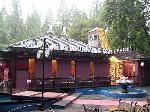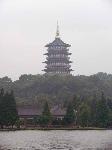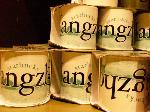- Getting around Lijiang. Dont stay in the Old Towns more than 2 days, there is nothing to do. KRISS Oct 9, 2013 05:46
- 2013 Beijing Temple Fair BENNYLAU Feb 26, 2013 03:29
- Malaysian traveling from KUL - LAX vis Shanghai PVG ZATI_DY Jan 3, 2013 20:15
Something Old and Something New
- Views: 4970
- |Vote: 0 0
- |Add to Favorites
- |Recommend to Friends
The Pick of the Bunch
It’s been said by some that Hangzhou is the perfect city, and that it is China’s most compelling destination. Nowhere else in China can you savour the nectar of China’s ancient past before such an idyllic backdrop, and then follow on by spending your evening in a first-class nightclub, restaurant, or café. For those travelling through the city, Hangzhou provides the kind of China highlight that will stand out in your memory as well as your photo album – this is a city even your mother could love, no matter how unenthusiastic she is about your determination to travel through this strange Oriental country.
As far as lifestyle is concerned, for those actually living in China, this is about the best choice you can make for your China home. I’m often asked by travellers who wish to stay on in China as English teachers which city is the best place to stay, and Hangzhou is usually the recommendation I make. The traditional foreigner centres of Beijing and Shanghai are overdone: the former is crowded and rough, the latter sleazy and pretentious. Smaller cities such as the beautiful Dalian and Qingdao offer the kinds of lifestyles foreigners typically enjoy, and in a more appealing and compact location, but are short on anything richly Chinese. Hangzhou has all the comforts of those others, with the addition of traditional, thoroughly Chinese scenery of heart-rending beauty; and it’s all in the same place, eliminating the need for making two hour bus excursions out of the city centre, as is necessary in Shanghai and Beijing.
Wealthier foreign visitors are well catered for in terms of accommodation – right on the shores of the West Lake are to be found some of Hangzhou’s classier hotels – the Sofitel stands right on the edge of the café district, and the luxurious Shangri-la is within five minute’s walk of the West Lake’s most scenic strolling areas. Those on a shoestring budget have their options covered too – right across from the train station are several hotels with fairly comfortable facilities, all of which you can book just by turning up at the door with a passport and valid visa. This area is replete with internet cafés also, so you’ll never be far away from letting those at home know what a fantastic place you’re staying in.
I fall into the latter category and had set up in a small, nicely air-conditioned room in the Hangzhou Hong Rui Hotel at the station gate; having set out to wander through the West Lake district, I’d been advised by a fellow passenger to take a lengthy detour, and as a result had been charmed by the ancient tea village at Longjing, and had then taken the opportunity to visit the park of Nine Streams and Misty Trees and the imposing Six Harmonies Pagoda on the shore of the Qiantang River. Having spent half the day on the outskirts of Hangzhou’s tourist arena, it was high time to get back on the K4 route public bus and make my way back to what is undeniably Hangzhou’s principal attraction – the shores of the West Lake.
The Convenience of the K4
The K4 seems to be a recent route – my 3 year-old map made no reference to it – and it’s one that seems to pass a fair number of Hangzhou’s attractions. Starting out from the Jiuxi Yanshu park area, it first passes the Qiantang River and the Six Harmonies Pagoda before continuing on to the West Lake area. Before it hits there, however, it passes another Hangzhou attraction of legendary status – the Dream of the Running Tiger Spring. Situated under White Crane Peak at the side of the Huichan Temple, the spring is said to have been created by two tigers who ran circles around the spot to bring up the water from beneath the earth sometime in the 9th century. They were the manifestation of a dream of a monk who lived in the temple and was about to abandon it for lack of running water. The mythical tigers are immortalised in a handsome statue that stands above the emerald spring waters, and visitors can also enjoy wandering around the temple grounds.
If you’re more interested in real animals, Hangzhou Zoo is the next stop along. Zoos in China generally do not enjoy a good reputation for animal welfare, and it’s said that Hangzhou’s zoo, in this regard, isn’t a good example of a caring environment for our four-legged friends. It’s a nice place to see pandas, especially in Hangzhou’s green leafed, misty atmosphere – but probably not a good place for the pandas themselves.
The next stop is another of Hangzhou’s very attractive old pagodas, the Leifeng Tower. The reason it looks sparklingly new is because it is – if you’d visited Hangzhou five years before, you’d have seen the remains of the original that was built in the year 975, resembling nothing much more impressive than a tall pile of bricks with holes for windows. The first tower, and the C12th/13th reconstruction, was much more remarkable, but had been damaged by lightening (like a suspiciously great number of China’s ancient buildings) at some point in history and finally almost completely collapsed in 1924. Tourism funds enabled the Hangzhou municipal government to rebuild the tower from the original blueprints stored in the archives at Qinghua University in Beijing, and the result is quite an astonishingly beautiful tower that is a notable feature of the West Lake scenic spectacle. Clearly visible from the lake shore at the side of Nanshan Road as well as from the walkways that span the breadth of the lake, Leifeng Tower stands five stories tall and features broad upturned eaves and clean white panelling. Needless to say, the view from the top of the tower itself is breathtaking, and it’s well worth the entrance fee – not only for the view, but also for some attractive dioramas of the legend of the lady snake, who fell in love with a man and transformed herself into human form, only to die of a broken heart and be laid to rest under the tower.
Living it up at the West Lake
I got off the K4 for the last time at the Wansong Ling Lu station as Hangzhou moved into evening. Wansong Ling Lu station is right on Nanshan Road and is the beginning of the West Lake’s exciting nightlife district, as well as the location of the Underwater Museum aquarium and a good place to stroll around the lake shore, from which the Leifeng Tower is clearly visible across the water. I’d also been told that this is the most inexpensive place to hire boats to sail on the West Lake, and I set off through the parklands on the shore to find the boat hire station.
I was unlucky on this occasion, as the rain had caused the boats to close shop, and it was impossible to hire one – but I enjoyed walking at the lake’s edge and watching all the pagodas and ornate bridges in the distance. I did get to check the prices, and they were reasonable – from the hire shop in this area, a bond of RMB100 will get you on the water, and the cost is only RMB20 per half hour – elsewhere on the West Lake you could be paying a couple of hundred for the same thing.
What did impress me was something I’d not seen a few years before when visiting Hangzhou – the proliferation of International bars and restaurants. Right near where I was walking at Wansong Ling Lu was a brand new night-club and a very large Thai/Singaporean restaurant. As I walked on along the lakeside, I counted Indian, Italian and a few other Western joints. The farther I walked, the more Hangzhou started to look like an international hybrid, and by the time darkness fell, I was already at one of the West Lake’s central nightlife districts – Xihu Tiandi.
I’d really not fully appreciated just how modern Hangzhou actually is until I strolled around the fashionable Xihu Tiandi area at the bottom of Xihu Dadao – the main road through Hangzhou’s city area. Twinkling with fairy lights and the neon glow of flashy store signs, Xihu Tiandi is host to such high-profile stores such as Häagen-dazs ice-cream and Starbucks coffee amongst others, as well as more obscure foreign brands like Oz-Donut and some smooth-rocking bars.
I’m a purist, and I dislike ostentatious commercial areas and gaudy night haunts with their excesses of neon and bad behaviour. However, as I wandered through Xihu Tiandi, I couldn’t help but feel that these guys had got everything right. The architecture reflected the traditional setting without appearing tacky and plastic, and still the causeway at the lake edge seemed to be stylish and born out of the modern age. I couldn’t help but wholeheartedly approve.
It had been a very revealing day, in any case: I had been all around the city on an independent highlights tour; I had feasted on the beauty of the ancient and austere as well as the trendy and luxurious. I couldn’t help but spend my evening guiltily enjoying my one foreigner’s concession – a large café latte.






 Copyright © 1998-2025 All rights reserved.
Copyright © 1998-2025 All rights reserved.
1.
Oct 15, 2006 22:53 Reply
XIEJIANFA said:
Mr Mishen, I envy you a lot that you are able to travel around China and write beautiful things about the places you hv been.How I wish i could be like U. As free as a bird.Only that U don't hv feathers( Ha! Ha! just joking) You make the places seem alive with yr beautiful enthusiastic words in yr reviews. Keep up the good work. I salute you! May life be kind to U ! cheerio.